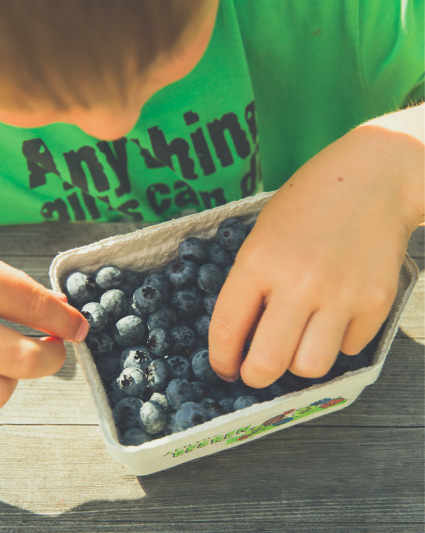The Simple Life Begins In The Garden
For anyone who has ever found joy in digging in the dirt or watching nature transform a seed into a sprout, and then a plant, you might not need to be convinced that gardening offers undeniable benefits. Gardening with children can amplify the fun, while passing skills, knowledge, and appreciation right on down the chain.Many children possess a natural curiosity about the world of nature. Planning and tending to a garden can deepen that interest, while also imparting a sense of stewardship and self-reliance among our next generation. Research also shows that working with dirt can boost the healthy “microbiome” of our bodies, the microorganisms that live on our skin, in our intestines, and in other regions of our body. The so-called “good bacteria” of the gut are part of that microbiome; these organisms help with digestion and absorption of nutrients. The health and vitality of one’s microbiome is now considered an indicator of overall physical and even mental health and well-being, giving us another good reason to play in the dirt.Fresh off the vine
Time and again I have read and heard anecdotes of children becoming more willing to eat fresh fruits and vegetables when they have had a hand in growing their own food. And, the movement toward planting edible yards and landscapes offers an exciting intersection of utility and beauty: Grow beautiful plant combinations that you can actually eat!Gardening can be done in small spaces with containers; or in cleared patches of yard. In effect, anywhere that the sun shines can be transformed into a space for growing. (Many options exist for shade gardening, too, but with a focus on edible plants, let’s consider first the sunny side.)Let this be your year to start a garden with a child, or children, in your lives. Don’t overthink it; there will always be room for improvement. Even the most accomplished gardeners will tell you that they are never truly done.What’s your fancy?
What kind of garden do you and your children want to create? A garden you can eat, or a garden you can clip, as in, flowers? Or a mix of both? There are many online resources for planning out garden plots (see sidebar). If you can narrow down your wishes, you probably will have more success preparing and caring for
your garden.Some plants lend themselves particularly well to a children’s garden. Included are radishes, with a quick maturation period; green beans, which grow relatively easily and can be (indeed, should be) eaten right off the vine; cherry tomatoes (ditto); lettuces, which come in many varieties and are easy to grow and clip; pumpkins (big fun); and a multitude of herbs, which often can tolerate lots of sun and/or a forgotten watering.Some books and web resources offer theme-based garden designs. “Pizza
gardens,” for example, can include tomatoes, onions or garlic, peppers of choice, and herbs like basil or parsley. Consider a round plot with pizza-like wedges delineated for
each plant.For a mix of edible beauty, consider an herb garden that attracts butterflies. Herbs like parsley, dill, and pineapple sage all beckon butterflies, those beguiling guests who also help with plant pollination.Nasturtium, with bright orange, red, or yellow flowers, can grow in poor soil and offer a great example of color and edibility. Throw a few of the peppery flowers or leaves in with your tender salad greens.As for culinary herbs: the list could go on forever. Parsley, thyme, rosemary, cilantro, basil (fresh pesto, anyone?). Let your taste, or that of your garden collaborators, serve as your guide.Choose your plants, based on your preferences and your available space. Some plants are easy to cultivate from seed, while for others, you might have more success with seedlings. Whether you start with seed or seedling depends on the particular plants you’ve chosen and will take just
a little research.Seeds are less expensive than seedlings, but for many vegetable plants, you might experience better luck, and a longer harvest window, by starting with seedlings. If you want to begin some plants from seed, consider “direct sowing” of seeds outdoors, rather than starting seeds indoors, which presents another layer of complexity. (see sidebar for best direct-sow seeds)Up high, down low
If you don’t have a lot of ground space, containers can be a great spot, especially for herbs and flowers. You can also grow vertically by staking frames for climbing plants, like beans or climbing flowers.Consult your kids to create a vision of your planting areas. A mix of container and ground plots might provide a balance of ease and control for you. Sketching out garden plots or containers can be a fun activity for experienced and novice gardeners alike.Ready to launch
As you plan your garden and choose your seedlings and seeds, take note of the maturity and harvest schedule for the plants in your plot or container. Vegetables like peas and broccoli thrive in cooler spring or fall temperatures. Dedicating one area to “early bloomers” will leave a hole when they’re done, so you might consider mixing up early, mid, and later-maturing plants. Or, you can re-plant an early
container or plot once it expires. You can find many resources in books and on the web showing planting and harvesting schedules, based on your zone. (Berryville is in Zone 6b, according to the USDA Plant Hardiness
Zone Map).Prepare your soil. The act of soil preparation ranges from dig and drop to meticulous balancing. Check out some primers on how to get your plot or containers ready for the plants of your choice, and for the sake of sanity perhaps err on the side of quick-n-easy over
scholarly. (see sidebar)What’s left after a little consideration and research? Getting to work! Let the fun and discovery unfold in your own backyard. Not to mention the unmatched pleasure from biting into a fresh-out-of-the-ground vegetable or herb, or giving away a bouquet of your own fresh-cut flowers.How Does Your Garden Grow?Browse garden plans,
like “tea garden” and “salad garden”bonnieplants.com/planting-plans
Best direct-sow seedsPlant Hardiness Zone Map
Preparing soil in springwww.rodalesorganiclife.com/garden/preparing-soil-spring
Best plants for kids’ gardens101 Kid-Friendly Plants, by Cindy Krezel tinyurl.com/seedwithkids











